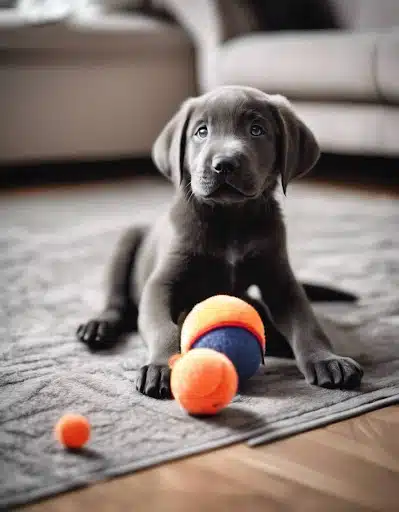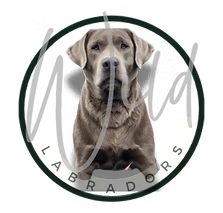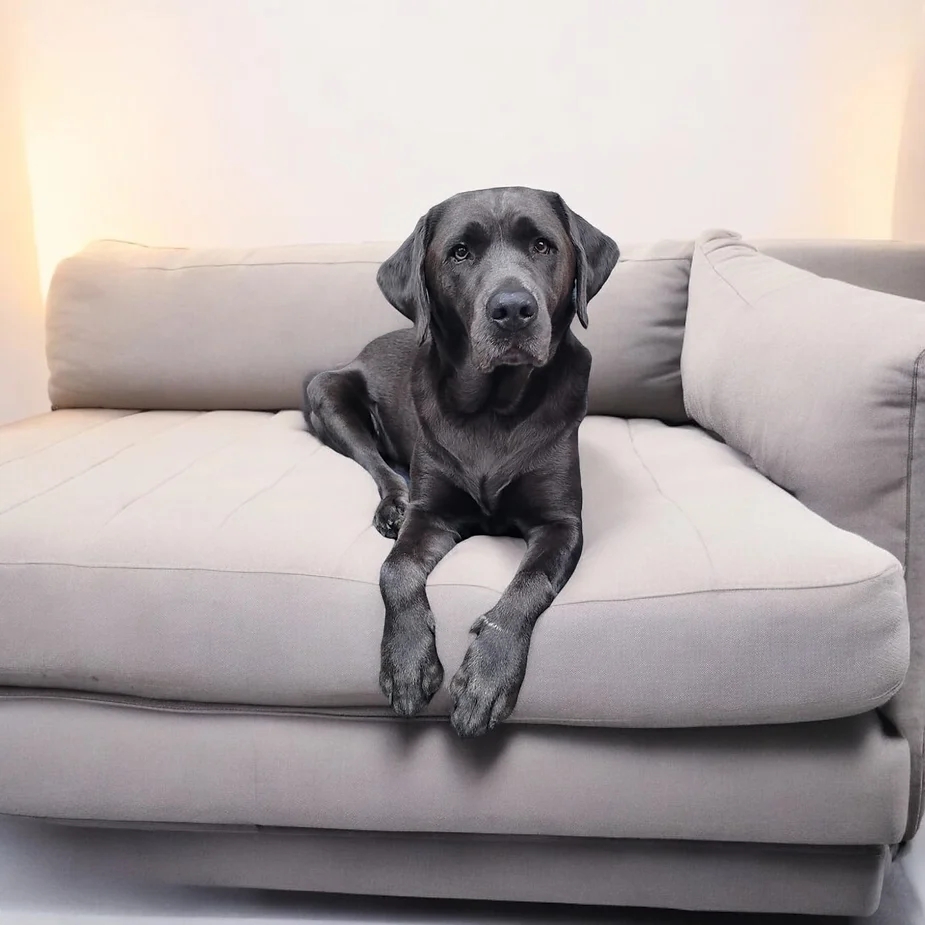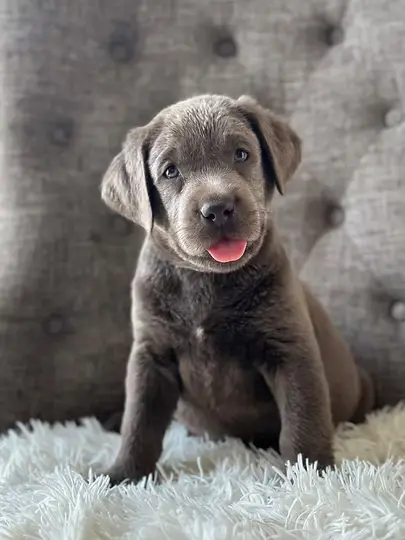Shh… I Have a Secret for You: Welcome to Wild Labradors’ Little Black Book on Puppy Training

Brace yourselves, puppy parents, because I’m about to reveal the ultimate, foolproof secrets of puppy training. Yes, this is the deep, dark puppy training black book I crafted back in 2017, packed with everything you need to survive (and thrive) with your new furry friend—whether it’s a chocolate lab puppy, a black English Labrador puppy, or a fox red Labrador with endless energy.
Whether you’re a first-time dog owner searching for Labrador puppies for sale or just need a refresher, this guide has you covered from the good, the bad, to the “Why is he eating my shoes again?” ugly. Spoiler alert: training a Labrador Retriever takes routine, structure, and a sense of humor. But stay with me because with a little consistency and patience, you’ll be well on your way to raising a well-mannered English Labrador Retriever.
Routine and Structure: The Puppy Training Magic
Let’s start with the biggie: routine. Puppy training isn’t something you can do halfway. If you’re willing to give your pup time, structure, and effort, you’re golden! Those first four months are critical for shaping your English Lab puppy into a polite, balanced companion. Routine helps your puppy feel safe and understand boundaries—it’s their “puppy playbook!” And remember, any negative behavior isn’t your puppy’s fault. It’s simply a sign that they need more guidance.
Secret Training Tool: The Hour-a-Day Leash Trick
Now, here’s my secret weapon for first-time Labrador Retriever owners. When your puppy is home (perhaps from one of our Lab litters for sale), start some low-key leash training—indoors!
- Leash Up: Attach the puppy’s collar and leash.
- Wrap It: Tie the leash around your waist, so your black Lab puppy naturally stays close to you just like a puppy shadow.
- Move and Command: As you go about your day dishes, laundry, or even scrolling listings for your next charcoal Lab puppy give a gentle “Come” command when you move. Reward them with a kibble nibble and some praise.
Want an extra command? Try “sit” each time you pause. This mental stimulation builds a strong bond and lays a foundation for lead manners something essential for strong, active breeds like the Silver Lab Puppy training.
Don’t Give Up: The Power of Patience and Accountability
Let’s be real. Puppy resentment is real. Whether you’ve got a blocky English Labrador, a tiny yellow Lab puppy, or a lovable Silver Labrador, the early days can test your patience.
But here’s the truth: your puppy’s success depends on your consistency. You’re not just training a dog you’re building a relationship that will last a lifetime. Remember, even adult English Labs for sale need structure, just like pups.
Quick Hit Puppy 101 Tips
Health is Wealth: All Wild Labradors puppies come with a HIP Dysplasia & Eye Guarantee—a promise we stand by for all our Labrador Retriever puppies for sale in Massachusetts.
Feeding & Nutrition: Stick to the same mealtime and feed them in a consistent spot. Great advice whether you’ve adopted an AKC-registered Lab puppy training or rescued an adult Lab for adoption.
Training Essentials: Crate training, potty training, redirection—it’s all part of raising a successful English Labrador puppy.
Socialization: From black Lab puppies to charcoal Labrador Retriever puppies, positive interaction is crucial.
Celebrate Wins: You may not get it perfect every day (especially when dealing with a high-energy fox red English Lab), but every small win counts.
Chewing 101: Designating the Right Spot
Whether it’s your reputable Lab breeder near me’s perfect pup or a yellow Labrador puppy training from Massachusetts, chewing is part of the process. Provide a designated toy basket and redirect them consistently—redirection is key!
• Redirection Is Key: When you catch your puppy training chewing something they shouldn’t (like the corner of your kitchen cabinet!), give a gentle but firm grasp on their snout, say “No,” and immediately bring them over to their toy basket. With consistency, they’ll start associating the basket with appropriate chewing.
• Always Supervise: If you can’t keep your eyes on them, say it with me—“They should be in the crate!” Crate time prevents negative behaviors when you’re not around to redirect.
Think of It Like a Toddler
Imagine you’re cooking dinner with a toddler in the house. You wouldn’t leave them unsupervised, right? Instead, you’d keep them gated off in a safe spot nearby. The same goes for puppies! Confine them to the kitchen with you, so you’re close enough to redirect unwanted behavior. But—and here’s the key difference—puppies don’t wear diapers! If they’re in a playpen out of sight, you’re likely to miss a piddle puddle, and that’s a hard habit to break. Crate time or close supervision is the best way to ensure they stay on the right track.
And Now… Your Daily Puppy Routine!
Morning: Out We Go!
Wake up and take that puppy outside! This is priority number one. Puppies need to go as soon as they wake up—whether it’s after a 5-minute nap or an 8-hour snooze. If they don’t go, don’t worry. Just give them the chance!
Breakfast Time: Routine is Key
• Feed your puppy training in the same spot each day to create consistency. Give them 15 minutes max, then pick up any leftovers.
• If you’ve got other dogs, supervise to prevent food snatching! Mixing dog diets = tummy troubles.
• Pro Tip: Let everyone in the family get involved with feeding time. Try touching the food bowl and gently taking it away. This lets your puppy know people are allowed near their food (without making them feel like it’s a game).
Bathroom Break… Again!
After any food or drink, it’s time for another bathroom trip. Puppies have tiny tummies, and they process things fast. Use cues like “Go pee” to build a routine and reward them with a high-pitched “Good boy/girl!” and maybe a treat. If you want your puppy to use a specific spot, start training them to associate that area with bathroom breaks.
Play, Adventure, & Boundaries
Puppies are little balls of energy, and they need time to burn it off. Play with your pup for at least 30 minutes before any long crate stays.
• Set up a safe zone where they can explore and stay out of trouble. Playpens or baby gates are lifesavers!
• If an accident happens, calmly pick them up mid-piddle or poo, and rush them outside. A quick “No” on the way helps them learn what’s acceptable.
Afternoon Potty Trip
Once you’re home, head outside right away! This helps keep their potty schedule on track. Over time, you won’t have to rush to the crate immediately; your pup will learn to patiently wait for you.
Daily Training: Puppies Love to Learn
Puppies want to please! Set aside a little time each day to teach basic commands like “Sit,” “Stay,” and “Come.”
• Use a high-energy “Good boy/girl!” and a bit of kibble as positive reinforcement. They’ll soon love showing off their skills!
Nipping: Teaching Boundaries (aka, “No Teeth, Please!”)
Nipping may be cute now, but no one wants an 80-pound dog playfully chomping on their hands. Here’s how to curb it early:
1. Hold their snout gently but firmly.
2. Make eye contact and give a loud, firm “NO.”
3. Keep that hold for about 5 seconds (don’t let go if they squirm).
4. Release and go back to play. Repeat as needed. It’s not instant, but they’ll get it!
Dinner Time: Same Rules as Breakfast
Feed your pup in their regular spot and pick up any leftovers after 15 minutes. Try to cut off water intake about three hours before bedtime to prevent midnight bathroom needs.
Evening Play & Calm-Down Time
After dinner, give them one last burst of playtime, then start winding down. Lower the lights, quiet things down, and avoid too much stimulation. After they’re nice and relaxed, take them outside for their final bathroom break.
Crate Training: The Magic of Commitment
A properly sized crate is your puppy’s happy place. Get one with a divider so you can adjust the space as they grow. This helps with bladder control and keeps them cozy.
• Commit to the crate : It might feel tough if they whine or bark, but let them learn to self-soothe. If they wake in the middle of the night, take them out quickly and put them right back in—no playtime! They’ll soon understand that the crate is for sleep, not a late-night party.
In Summary: You’ve Got This!
Yes, puppies are work, and no one said it would be easy. But remember, all your efforts now will pay off. Stick with the routine, stay patient, and don’t forget to laugh along the way. You’re building the foundation for a loyal, loving companion, and it’s so worth it. Enjoy the journey!
If you’re as dog-obsessed as I am, you know Cesar Millan is a legend. His insights on dog psychology and behavior are my guiding light. Understanding why dogs behave as they do is half the battle. It’s about creating a connection that goes beyond just commands. You’re becoming your puppy’s world—so make it a positive, structured, and loving one!
Raising a puppy is a wild ride, but it’s incredibly rewarding when you see that tail wag, and those puppy eyes look to you with trust. Take these secrets, add a dash of patience, and trust in the journey. You’ve got this, and remember—your puppy is learning from you every step of the way!









Responses